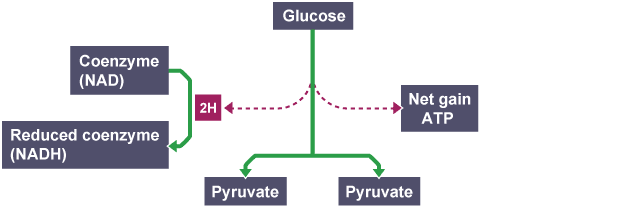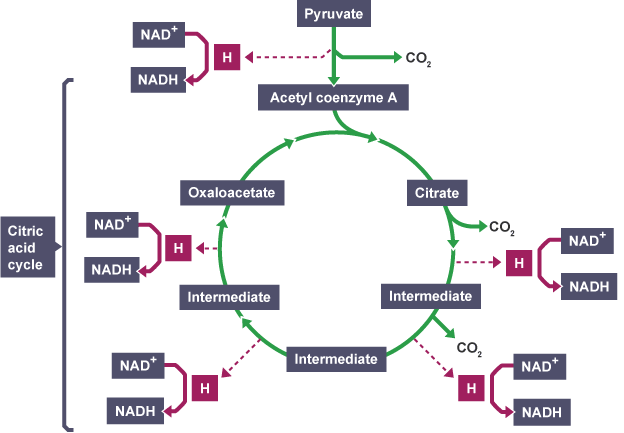Chapters
In this article, we will discuss the Krebs cycle in detail. So, let us get started.

Introduction
Glucose molecule in living organisms is processed to obtain energy. This energy is obtained in ATP form. When a cell in living organisms takes up the glucose molecule, the cytoplasm in the cell breaks down this molecule into pyruvate during glycolysis. The subsequent action depends on whether the pyruvate enters the aerobic respiration or anaerobic respiration path. The end of the glycolysis process produces two pyruvate molecules that still have sufficient energy for the cell to use. After glycolysis, pyruvate oxidation and Krebs cycle occur.
Pathways of Respiration
Glucose is the primary substrate within the respiratory pathway. The metabolic pathway of respiration can be divided into the following three parts:
- Glycolysis occurs in the cytoplasm of the cell
- The Krebs cycle that takes place in the matrix of the mitochondria
- Electron transport chain that takes place in the inner membrane of the mitochondria
Before proceeding to the Krebs cycle, first, we will discuss pyruvate oxidation.
Pyruvate Oxidation Explained
Pyruvate oxidation links glycolysis and the Krebs cycle and has a much shorter span than other steps of cellular respiration. Pyruvate which is a three-carbon molecule is transformed into acetyl CoA which is a two-carbon molecule connected with coenzyme A. As a result of this reaction, a molecule of carbon dioxide and NADH are released, NADH is a reduced form of NAD+.
Pyruvate oxidation in eukaryotes happens in the matrix of the cell. Acetyl CoA is the key that drives Krebs cycle. The Krebs cycle is also referred to as a citric acid cycle. The pyruvate should enter the mitochondrion of the cell, pass through its inner membrane to the matrix before the start of the reactions in this process. Pyruvate modification occurs in the matrix using the following steps:
- First, a carboxyl group is eliminated from pyruvate and released as carbon dioxide,
- Two-carbon dioxide molecule which is produced as a result of this reaction is oxidized and NAD+ is converted into NADH. The lost electrons from the two-carbon dioxide molecule are accepted by NAD+. It means that NAD+ acts as an electron receptor.
- The oxidized two-carbon molecule is attached to Coenzyme A to generate acetyl CoA which transfers the acetyl group to the next process, i.e. the Krebs cycle.
A large enzyme complex known as pyruvate dehydrogenase complex plays a central role in carrying out the steps discussed above. This enzyme has three component enzymes and has more than 60 subunits. The pyruvate dehydrogenase is responsible for regulating the amount of acetyl-CoA that can enter the Krebs cycle. During pyruvate oxidation, two molecules of pyruvate are transformed into two acetyl CoA molecules for each molecule of glucose. As a result, two carbons as carbon dioxide are released and two NADH are formed from NAD+.
The Krebs cycle vs Glycolysis
Although both glycolysis and the Krebs cycle generate ATP from substrates, however, the Krebs cycle produces significantly higher ATP molecules as compared to glycolysis. A specialized enzyme catalyzes each process. Another difference between the Krebs cycle and glycolysis is that the Krebs cycle occurs in both aerobic and anaerobic respiration. On the other hand, glycolysis only occurs in anaerobic respiration.

In the next section, we will discuss the Krebs cycle in detail.
The Krebs cycle
In eukaryotic cells, the Krebs cycle refers to the series of reactions that occur in the mitochondria of the cell. The Krebs cycle occurs after the process of glycolysis only in the presence of oxygen. It means that the Krebs cycle is an aerobic process. This process involves the entrance of pyruvate in the matrix of mitochondria and the removal of carbon dioxide.
This cycle involves eight steps that are controlled by enzymes. The objective of the Krebs cycle is to accumulate high-energy electrons from the reactions that occur during the process. The carries of these electrons are NADH and FADH2. These carries move these electrons to the next steps of respiration.
- First, in the glucose metabolism, 2 carbon (2C) Acetyl CoA enters the circular pathway from the link reaction
- After the breakdown of lipids, acetyl CoA is created from fatty acids. There is a direct entry of amino acids into the Krebs cycle from other metabolic pathways
- 6 carbon (6C) citrate is formed when 4 carbon (4C) oxaloacetate accepts 2C acetyl fragment from acetyl CoA
- As a result of this reaction, coenzyme A is released
- A series of oxidation-reduction reactions also known as redox reactions convert citrate back to oxaloacetate.
Oxaloacetate Regenerated
A series of redox reactions regenerate oxaloacetate in the Krebs cycle. Decarboxylation of citrate releases two carbon dioxide as waste gas. As a result of oxidation (dehydrogenation) of citrate, H atoms have released that result in the reduction of coenzymes NAD and FAD. The equation of this reaction is given below:
3NAD + 1 FAD  3NADH +
3NADH +  + 1 FADH
+ 1 FADH
Substrate-linked phosphorylation also occurs which results in the transfer of phosphate from one of the intermediates to ADP to form a single ATP.

Summary of the Process
The summary of the Krebs cycle is given below:
- There is a need for pyruvate oxidation by pyruvate dehydrogenase complex before the start of the Krebs cycle.
- Two molecules of acetyl CoA are generated from two molecules of pyruvate.
- A series of enzyme controlled reactions that occur in the cycle generates 2 ATP, 6 NADH, 2 FADH2, 4
 , and 6
, and 6  from each glucose molecule
from each glucose molecule - The high-energy electron carriers NADH and FADH2 then move to the electron transport chain to assist the ATP production.
Electron Transport Chain
It is the final stage of the respiratory pathway. The majority of the ATP molecules are produced in this stage. This process involves the accumulation of proteins present on the inner membrane of mitochondria. The hydrogen ions and electrons are released from NADH into the transport chain.
There is a transfer of energy from the electrons to the proteins in the membrane. This transfer provides energy for the hydrogen ions which can be pumped across the inner membrane of mitochondria. A protein referred to as an ATP synthase synthesizes the flow of ions back across the membrane.
The last hydrogen ion and electron acceptor is oxygen. It combines with electrons and hydrogen ions to create water.













Keep on teaching us,you are excellent teachers
This is great
Thanks a lot for this book,it really helped me a lot
It’s useful to me
Thanks a lot for your Better book!
It’s a perfect article, go ahead